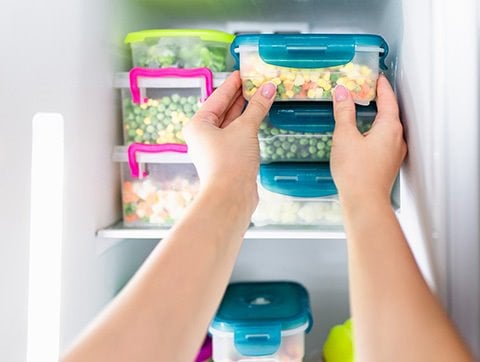Food Storage and Shelf Life
Ever wonder what all those numbers mean on canned, boxed or packaged food products? This video from IFT features Richard Ross, CEO of Ross Consulting LLC, discussing shelf-life of food, proper storage, expiration dates, lot codes and what it all means for you and your family.

Health-conscious consumers are paying closer attention to the numbers and dates stamped on the bottom of their favorite cereals, canned goods, packaged snacks and even fresh produce. But what do all these numbers really mean?
KNOW YOUR NUMBERS
Most U.S. food companies stamp lot codes and/or expiration dates on their products. There are two types of codes:
- Lot Code: When manufacturers produce a product, they do so in batches. Each batch is assigned a unique series of numbers that makes it possible for manufacturers to track exactly when a problem occurred and which products need to be recalled.
- Expiration Dates: These are numbers represented in a date format that are used to provide a guideline for consumers so they will know when a food product is either no longer safe to eat or might not taste as good as it did when originally produced.
SHELF-LIFE LINGO
There is little government regulation when it comes to expiration dates stamped on packages. Therefore, don't treat expiration dates or lot codes with a "one-size fits all" approach.
According to the United States Department of Agriculture (USDA) Food Safety and Inspection Service, there are a few different types of dates you should look for:
- Sell By: is a guide for stores to know how long they can display a product before its quality begins to diminish. An item will be edible for some time after the "sell by" date, but it is no longer the highest possible level of quality.
- Best if Used By/Best Before: is a guide to the quality or flavor profile of the food and does not refer to safety. For example, sour cream may grow increasingly sour over time, but it remains safe to consume even when past the point of peak freshness.
- Use By: is the closest to an expiration date similar to that on medicines. Using them after the date is not recommended. In some instances, medicines may be ineffective past their "use by" date and food may lose nutrients, develop potentially harmful bacteria and lessen in quality.
FOOD PRODUCT TLC
When you're shopping for food, be sure to examine the packaging for dents, tears or broken seals. No matter what the date on the outside of the package says, there are ways you can care for products to help maintain their shelf life. Temperature, humidity and light can all affect the quality of a product, especially when it comes to meat, dairy and other highly perishable products.
- Freezer Facts: The temp in your freezer should always be 0°FFreezing food is a great way to prolong the life of leftovers or store food to be used at a later date. However, it must be noted that while freezing can preserve food safety and it can also sometimes affect the way the food tastes after defrosting. For optimal quality, frozen beef needs to be consumed within three months, while pork keeps in the freezer for six months and lamb, veal, poultry and venison hold between 8-12 months.
- Storage Safety: When buying perishable food, such as meat, poultry, dairy products and certain types of fruit and vegetables, bring the food home promptly after purchase and refrigerate it accordingly. If you aren't able to use it in a timely fashion, store it in the freezer to avoid spoilage. If you're not able to refrigerate or freeze perishables immediately, be sure they are stored at a temperature of 40°F or below by using insulated bags, ice or keep a cooler in the back of your car for transporting perishable groceries.
IFTNEXT

Episode 29: All About Food Safety Culture
In this podcast, we discuss food safety culture, including how food safety culture is established, measured, and how they are expected to change in light of ongoing advancements in food science and policy. Our guests include Hugo Gutierrez, Global Food Safety and Quality Officer for Kerry, and Bob Gravani, Professor Emeritus of Food Science and Director Emeritus of the National Good Agricultural Practices (GAPs) Program at Cornell University.
Episode 20: Trends and Consumer Behaviors in the time of COVID-19: Food Service
The COVID-19 pandemic continues to pull the global food system into new and uncertain territory. Much of this uncertainty stems from rapid shifts in consumer behaviors as a result of our collective 'new normal'.
